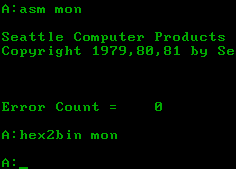86-DOS
| QDOS, 86-DOS | |
|---|---|
|
|
|
 86-DOS with HEX2BIN |
|
| developer | SCP / Tim Paterson |
| License (s) | proprietary |
| First publ. | 1980 |
| Current version | 1.14 (1981) |
| Kernel | monolithic ( assembler ) |
| ancestry | QDOS / 86-DOS |
| Architecture (s) | 8086 |
| timeline | QDOS 0.10 86-DOS 0.3 to 1.14 |
86-DOS was an operating system from Seattle Computer Products (SCP) for the Intel 8086 microprocessor .
In the development in 1980 QDOS ( " q uick and d irty o perating s ystem" called), the name was the same year in 86-DOS changed, began as SCP, awarded the operating system license. After the takeover by Microsoft in 1981 , 86 -DOS was further developed into MS-DOS .
Development and functions
QDOS was written by Tim Paterson in 1980 . Seattle Computer Products needed an 8086 operating system to sell their 8086 CPU board - which was also developed by Tim Paterson. Since there was still no 8086 version of the CP / M operating system, which was most popular at the time - one only came onto the market in January 1982 under the name CP / M-86 - SCP took on the matter itself and developed QDOS.
QDOS was very similar to CP / M in that Paterson used a CP / M 2.2 system manual for reference. Some functions were taken directly from CP / M, in particular the command structure and the programming interface were similar. Porting CP / M programs was therefore relatively problem-free.
However QDOS offered some improvements to the file management, especially the use of the recently from Microsoft developed FAT - File system . This was u. a. handling of large files, which had been very cumbersome with CP / M. In addition, information about the file system was no longer stored in the main memory as it was with CP / M, but updated with every action on the data carrier. While this procedure was a little slower, it reduced the risk of data corruption if the disk was not manually updated before removal.
Further development to MS-DOS
After IBM had developed its first personal computer in October 1980 , the company was looking for a suitable operating system. After no agreement had been reached on licensing CP / M, the most widespread operating system at the time, Microsoft bought 86-DOS from SCP, developed it further into MS-DOS and licensed it to IBM. Due to the great success of the IBM PC , MS-DOS (or the very similar PC DOS ) and its successors and replicas in the 1980s and early 1990s became the most widely used operating system worldwide.
See also
The 86 DOS instruction set is listed in the list of command line commands (DOS) .
Individual evidence
- ↑ cf. Triumph of the Nerds: The Rise of Accidental Empires , Season 1, PBS, transcript of the show (1996, engl.)
- ↑ cf. Paul Freiberger, Michael Swaine: Fire in the Valley: The Making of the Personal Computer . 2nd ed., New York 2000, ISBN 0-07-135892-7 , pp. 332f.
Web links
- History of MS-DOS on Paterson Technology
- Manuals for 86-DOS on Paterson Technology